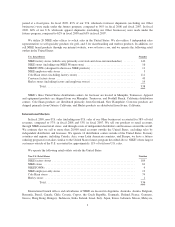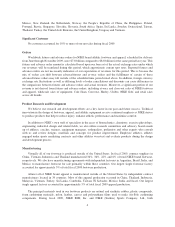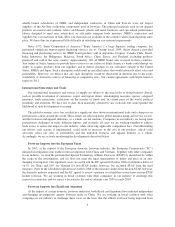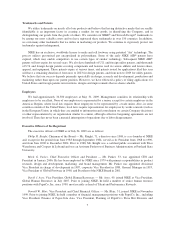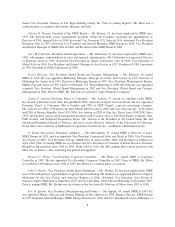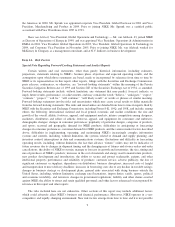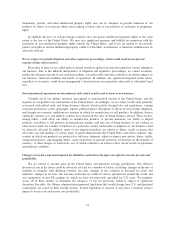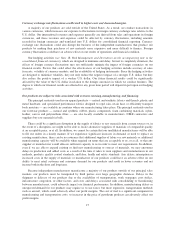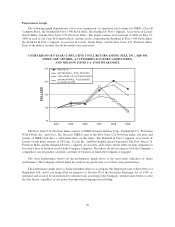Nike 2009 Annual Report Download - page 15
Download and view the complete annual report
Please find page 15 of the 2009 Nike annual report below. You can navigate through the pages in the report by either clicking on the pages listed below, or by using the keyword search tool below to find specific information within the annual report.excess products ordered from manufacturers. Inventory levels in excess of customer demand may result in
inventory write-downs, and the sale of excess inventory at discounted prices could significantly impair our brand
image and have an adverse effect on our operating results and financial condition. Conversely, if we
underestimate consumer demand for our products or if our manufacturers fail to supply products we require at
the time we need them, we may experience inventory shortages. Inventory shortages might delay shipments to
customers, negatively impact retailer and distributor relationships, and diminish brand loyalty.
The difficulty in forecasting demand also makes it difficult to estimate our future results of operations and
financial condition from period to period. A failure to accurately predict the level of demand for our products
could adversely affect our net revenues and net income, and we are unlikely to forecast such effects with any
certainty in advance.
We may be adversely affected by the financial health of our retailers.
We extend credit to our customers based on an assessment of a customer’s financial condition, generally
without requiring collateral. To assist in the scheduling of production and the shipping of seasonal products, we
offer customers the ability to place orders five to six months ahead of delivery under our “futures” ordering
program. These advance orders may be cancelled, and the risk of cancellation may increase when dealing with
financially ailing retailers or retailers struggling with economic uncertainty. In the past, some customers have
experienced financial difficulties, which have had an adverse effect on our business. As a result, retailers may be
more cautious than usual with orders as a result of weakness in the retail economy. A slowing economy in our
key markets could have an adverse effect on the financial health of our customers, which in turn could have an
adverse effect on our results of operations and financial condition. In addition, product sales are dependent in
part on high quality merchandising and an appealing store environment to attract consumers, which requires
continuing investments by retailers. Retailers who experience financial difficulties may fail to make such
investments or delay them, resulting in lower sales and orders for our products.
Consolidation of retailers or concentration of retail market share among a few retailers may increase and
concentrate our credit risk, and impair our ability to sell our products.
The athletic footwear, apparel, and equipment retail markets in some countries are dominated by a few large
athletic footwear, apparel, and equipment retailers with many stores. These retailers have in the past increased
their market share and may continue to do so in the future by expanding through acquisitions and construction of
additional stores. These situations concentrate our credit risk with a relatively small number of retailers, and, if
any of these retailers were to experience a shortage of liquidity, it would increase the risk that their outstanding
payables to us may not be paid. In addition, increasing market share concentration among one or a few retailers
in a particular country or region increases the risk that if any one of them substantially reduces their purchases of
our products, we may be unable to find a sufficient number of other retail outlets for our products to sustain the
same level of sales and revenues.
Failure to adequately protect our intellectual property rights could adversely affect our business.
We utilize trademarks on nearly all of our products and believe that having distinctive marks that are readily
identifiable is an important factor in creating a market for our goods, in identifying us, and in distinguishing our
goods from the goods of others. We consider our NIKE®and Swoosh Design®trademarks to be among our most
valuable assets and we have registered these trademarks in over 150 countries. In addition, we own many other
trademarks that we utilize in marketing our products. We believe that our trademarks, patents, and other
intellectual property rights are important to our brand, our success and our competitive position. We periodically
discover products that are counterfeit reproductions of our products or that otherwise infringe on our intellectual
property rights. If we are unsuccessful in challenging a party’s products on the basis of trademark or design or
utility patent infringement, continued sales of these products could adversely affect our sales and our brand and
result in the shift of consumer preference away from our products. The actions we take to establish and protect
13


